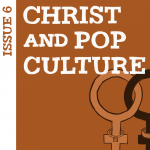The following is an excerpt from an exclusive feature available only in Issue #6 of the Christ and Pop Culture Magazine. For more features like this, download our app for iPad and iPhone from Apple’s App Store.
After a one-week free trial, monthly and yearly subscriptions are available for $2.99 and $29.99 respectively. New issues are made available every other week. More information here.
Too often, the term “gay marriage” lands on the table with a thud and Christians seize on the “gay” part. Let’s be very clear: our sexual mores are not a basis for public policy.
Missing this point wastes so much time. Very few people suggest prohibiting homosexual relationships or homosexual behavior. Regardless of your position on the wisdom of such attempts, the ship sailed on that long ago. Whether it is worth your time to advocate for such policies is your decision to make, but it is not a conversation that the public is having, and it is not the issue in any of the marriage policy debates.
That’s not to say that homosexual sex is irrelevant to the debate — far from it! For some, homosexual sex isn’t really sex at all, but rather, a harmful and cheap facsimile that cannot consummate marriage. For others, it is a different mode of expressing “pair-bonding” intimacy and adds to the case for allowing same-sex marriage. However, talking about the physical act alone tells us little about marriage policy. Failing to connect it to the debate risks the credibility of the speaker.
This applies whether you are a traditionalist observing that same-sex partners don’t fit together in certain ways, or a revisionist ascribing opposition to a simple “ick” factor. These observations are a premise, not a conclusion. You still need to make an argument.
What Is Marriage?
It is impossible to discuss marriage policy without a robust conception of what marriage actually is. My experience is that skipping this question leads to endless misunderstanding. Starting here will still lead to deep, visceral disagreement, but will at least keep us from lobbing Jesus and Macklemore quote grenades back and forth.
The Book of Common Prayer describes marriage with characteristic beauty:
“…an honourable estate, instituted of God in the time of man’s innocency, signifying unto us the mystical union that is betwixt Christ and his Church; which holy estate Christ adorned and beautified with his presence, and first miracle that he wrought, in Cana of Galilee; and is commended of Saint Paul to be honourable among all men: and therefore is not by any to be enterprised, nor taken in hand, unadvisedly, lightly, or wantonly, to satisfy men’s carnal lusts and appetites, like brute beasts that have no understanding; but reverently, discreetly, advisedly, soberly, and in the fear of God; duly considering the causes for which Matrimony was ordained.”
The sublimity of that passage is inspiring, but it is not a reason to make the law a certain way. For starters, a lot of people disagree with it. Religious arguments are not sufficient to create public policy. The Bible is a true book and its teachings bind the conscience, but it does not follow that all of its strictures are matters for public regulation. Law is the authority by which matters of public concern are regulated. Thus, the discussion needs to start there.
Nor can history or (secular) tradition determine the outcome. These things can and should guide us, but they cannot rule the living. For starters, most of us are ill-equipped to discuss the history of marriage. Sure, Blackstone talked about marriage channeling babymaking urges. But did you know that the Romans had two different kinds of marriage, one of which the church tried to appropriate and strengthen? John Locke thought that once upbringing and inheritance were settled, spouses should be able to divorce at will.
Christian orthodoxy may not logically compel any particular view of marriage as a metaphysical reality, and in fact, it is not wholly ridiculous to hold that marriage really is mostly a social institution. I think that view is wrong, Biblically and philosophically, but the important thing is to make the definition part of the conversation.
What features must a relationship have to warrant public recognition? There are two answers vying for supremacy. Judge Walker, the federal district court judge who blocked California’s Proposition 8, defined marriage this way:
Marriage is the state recognition and approval of a couple’s choice to live with each other, to remain committed to one another, and to form a household based on their own feelings about one another, and their agreement to join in an economic partnership and support one another in terms of the material needs of life.
This is what I referred to above as the “love + consent” view. If this view is right, then it really is arbitrary discrimination to exclude some from participating solely on the basis of their chosen partner’s gender. On this view, marriage law is about affirming individuals in their life choices and promoting a general stability between consenting adult relationships.
Sherif Girgis, et al., define marriage this way:
Marriage is the union of a man and a woman who make a permanent and exclusive commitment to each other of the type that is naturally (inherently) fulfilled by bearing and rearing children together.
They call this the “conjugal” view because it is based on the uniquely conjugal nature of man-woman pairs. On this view, marriage’s public purpose is to channel the natural impulses of human beings that lead to children, and to ensure that children are raised by their biological parents to the extent possible. You can also call this the “procreative” or “child-centric” view.
Judge Walker’s skepticism might be excused. Even if marriage really is as the second definition describes (as I believe it must be), most of us stopped treating it that way a long time ago. Even many orthodox, conservative Christians talk about marriage as if it were primarily the recognition of an emotional connection. Put simply, our neglect of marriage started long before DOMA. No-fault divorce is the most commonly identified villain, a development that took over forty years to overcome the cultural capital that protected the institution of marriage.
Is marriage really about procreation? The answer is “yes.” Metaphysically, there is always this particular relationship that one can deduce from human nature and biology. But the answer is also “no.” Sociologically, we’ve been incoherent on this for decades, maybe longer. It looks mighty suspicious for us to treat our own marriages like an official registry of long-term special-friends with benefits, then turn around and say that’s not really what it is. A common refrain from libertarians or conflict-avoiders is the call to get government out of the marriage business altogether. Maybe that would be best, but first it requires us to adopt a very specific view of marriage.
Is marriage a purely private institution, or is it essentially public? As Christian marriage practice is to our shame, so too is our slippery grasp of marriage as a public good. If you want to see just how much we’ve lost, ask a typical traditionalist why elderly people are allowed to marry if marriage is about procreation. There are effective responses of varying quality to this facile objection, but it’s likely that you won’t get one. Pro tip: If the modern mind can’t reconcile a rather obvious example with millennia of social practice, chances are the problem is with the modern mind. This is not an argument from tradition, but a warning about easily surrendering to the zeitgeist.
Thousands of pages have been spilled on the question of the essence of marriage. Here, it will have to suffice to insist that we begin with the question, “What must something be to count as a marriage?” A full treatment of this discussion is far too much for this short article. For more, I highly recommend starting with this book (the source of many of my terms and arguments), but for those so inclined, an excellent place to canvass the serious arguments is to follow the conversation found here. Starting the conversation here, however, will avoid confusion and discord and may even help save some relationships from the strife of misunderstanding.
To read the rest of this thorough and thoughtful feature, download Issue #6 of CaPCMag from the Apple App Store today!
Illustration courtesy of Seth T. Hahne. Check out Seth’s graphic novel and comic review site, Good Ok Bad.










